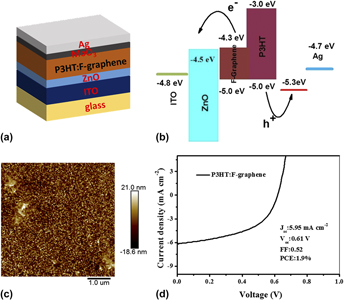Article contents
Solution-processed P3HT-functional graphene for efficient heterojunction organic photoelectronics
Published online by Cambridge University Press: 13 July 2016
Abstract

A facile method that allows chemical functionalization of graphene sheets is described. These result in a solution processable graphene-based material, namely F-graphene, which can be integrated in organic photoelectronic devices, due to its unique structural and photophysical properties. The resultant poly(3-hexylthiophene)(P3HT):F-graphene are soluble in common organic solvents, facilitating the structure/property characterization and the device fabrication by solution processing. The synthesized F-graphene is blended with the conjugated polymer in optimized concentration. The high and sensitive photoresponse of P3HT:F-graphene was demonstrated by the photodetector. A heterojunction photovoltaic device based on the solution-cast P3HT:F-graphene (with a BHJ structure of ITO/ZnO/P3HT:F-graphene/MoO3/Ag) showed a power conversion efficiency of 1.9% under AM1.5 illumination (100 mW/cm2). It provides a new method for graphene application in organic photoelectronics. It can easily enhance the performance of devices by optimizing the structure and bulk heterojunction blend in the near future.
- Type
- Articles
- Information
- Copyright
- Copyright © Materials Research Society 2016
Footnotes
Contributing Editor: Sam Zhang
References
REFERENCES
- 3
- Cited by



